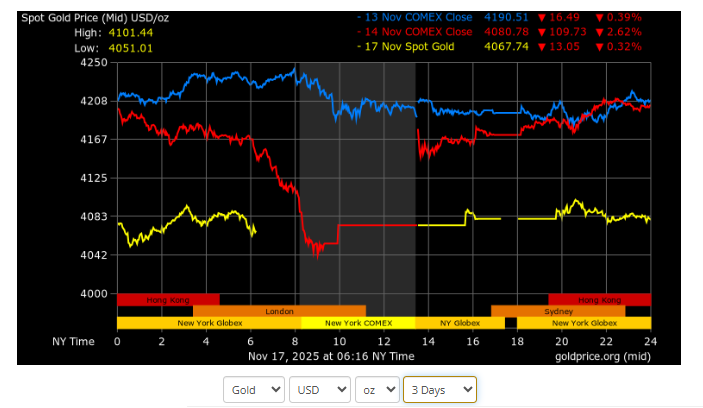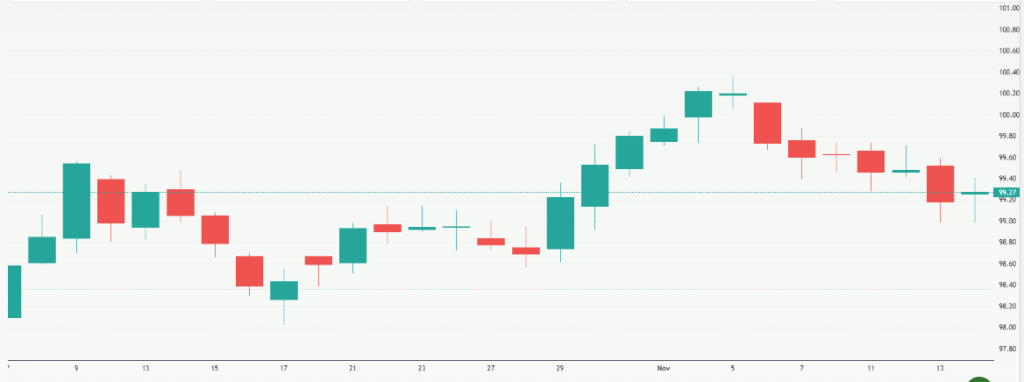Gold Price Today, Nov 17: Slips Third Day as US Rate Cut Hopes Dim
Gold price continued to fall on November 17, 2025, marking the third straight day of decline. This trend surprised many traders because gold usually holds steady during uncertain times. But this week, the mood in the market changed fast. Strong economic signals from the United States made investors rethink their expectations for early interest rate cuts. When rate cuts look unlikely, gold often loses some shine. This is because higher interest rates make other assets more attractive than gold.
The US dollar also gained strength this week. A stronger dollar usually puts pressure on gold since it becomes more expensive for buyers in other countries. Bond yields also moved higher, and that added more weight to gold’s movement.
Many investors are now watching global markets with caution. They want a clearer signal from the US Federal Reserve before making big moves. As we enter the second half of November, the gold market is showing how sensitive it is to policy news and economic trends.
What’s Driving Today’s Gold Price Drop?

Gold fell again on November 17, 2025. Traders cut bets on an early Federal Reserve rate reduction. Strong U.S. economic signals reduced the odds of a December cut. That shift hit gold because bullion pays no interest. Higher yields on U.S. Treasury notes made yield-bearing assets more attractive. The U.S. dollar strengthened.

A firmer dollar raises the cost of gold for overseas buyers. Exchange-traded fund holdings also dipped, removing some near-term support for prices. These combined forces pressured spot and futures markets on Monday.
US Rate Cut Expectations: Why They Matter for Gold?
Gold reacts strongly to Fed expectations. Lower interest rates usually help gold. That is because low rates reduce the opportunity cost of holding non-yielding assets. When rate cuts seem less likely, gold often weakens. Recent hawkish comments from some Fed officials reduced market optimism about a December cut. Traders now price in a smaller chance of easing. That recalibration has consequences for the immediate price path of bullion and for investor positioning in gold-related assets.
Gold Price Drop: Global Market Overview
Spot gold and U.S. futures both fell on Nov 17. Spot prices slipped toward the low-$4,000s per ounce region. U.S. futures also recorded declines as the dollar rose. Global trading centers showed mixed moves. London trading was cautious. Asian markets opened lower on the cue from New York. Overall, the tone turned defensive rather than risk-seeking.
Volume spikes accompanied the sell-off, indicating forced repositioning by some traders after last week’s rally. Market participants called the session a technical pullback after heavy gains earlier in November.
Indian Market Update
Domestic bullion traded lower on Nov 17. MCX December gold futures weakened in early trade. Prices hovered around ₹122,700-₹123,400 per 10 grams during morning deals. The rupee’s modest weakness compounded the fall. Local demand also showed caution after a strong run through the wedding season and festivals.

Jewelers indicated muted buying interest on Monday as international cues weighed on sentiment. Analysts in Mumbai flagged ₹1,22,000 per 10 grams as a key support. A breakdown below that level could invite further downside.
Investor Sentiment and Short-Term Outlook
Sentiment turned cautious after Friday’s sharp sell-off. Some traders reduced long exposure. Others used the dip to add hedges. Short-term momentum favors bears until clearer Fed guidance appears. Technical charts point to immediate support near $4,020-$4,050 an ounce. Resistance lies near last week’s highs in the low-$4,200s.
ETF flows and commodity positioning will matter in the coming days. A return of safe-haven demand could lift prices quickly. Conversely, stronger U.S. labor or inflation readings could push yields higher and pressure gold further. The market remains finely balanced.
Implications for Traders and Long-Term Investors
Short-term traders should watch real yields and the dollar. Volatility may persist until major U.S. data arrives. Long-term investors should consider gold’s broader role. The metal still offers portfolio diversification and inflation protection. Central bank purchases and geopolitical uncertainty support the bull case over a multi-quarter horizon.
However, timing trades around Fed communication is crucial. Tools that model rate expectations and flows can help. Mention of an AI stock research analysis tool may be useful for sophisticated modelling of correlations and flows. Use such tools prudently, and do not rely on them exclusively.
Gold Price: What to Watch Next?
Key U.S. data will shape the next leg for gold. Look for employment prints, inflation metrics, and retail figures this week. Fed speakers’ comments will also matter. Bond auctions and Treasury yield moves deserve attention. On the domestic side, rupee trends and local physical demand will influence Indian prices.
Geopolitical incidents or fresh central-bank buying could shift flows abruptly. Monitor ETF holdings and large-position changes in futures to gauge investor sentiment. These inputs will determine whether the pullback is a pause or a deeper correction.
Wrap Up
On November 17, 2025, gold slipped for a third straight day. The main driver was fading hopes for an imminent Fed rate cut. A firmer dollar and rising Treasury yields added pressure. Domestic markets echoed the global move and showed softness in early trade.
The short-term outlook is mixed and depends on forthcoming U.S. data and Fed signals. Long-term fundamentals remain supportive, but near-term risk is higher. Traders should manage risk and watch macro updates closely.
Frequently Asked Questions (FAQs)
Gold prices fell on November 17, 2025, because hopes for early U.S. rate cuts dropped. A stronger dollar and higher bond yields also pushed gold lower in global markets.
Gold is sensitive to interest rates. When rates stay high, gold becomes less attractive because it gives no income. When rate cuts seem unlikely, gold often moves down.
Gold may move up or down this week. It depends on new U.S. data and market signals. Traders are watching inflation and jobs reports before making strong decisions.
Disclaimer: The content shared by Meyka AI PTY LTD is solely for research and informational purposes. Meyka is not a financial advisory service, and the information provided should not be considered investment or trading advice.






